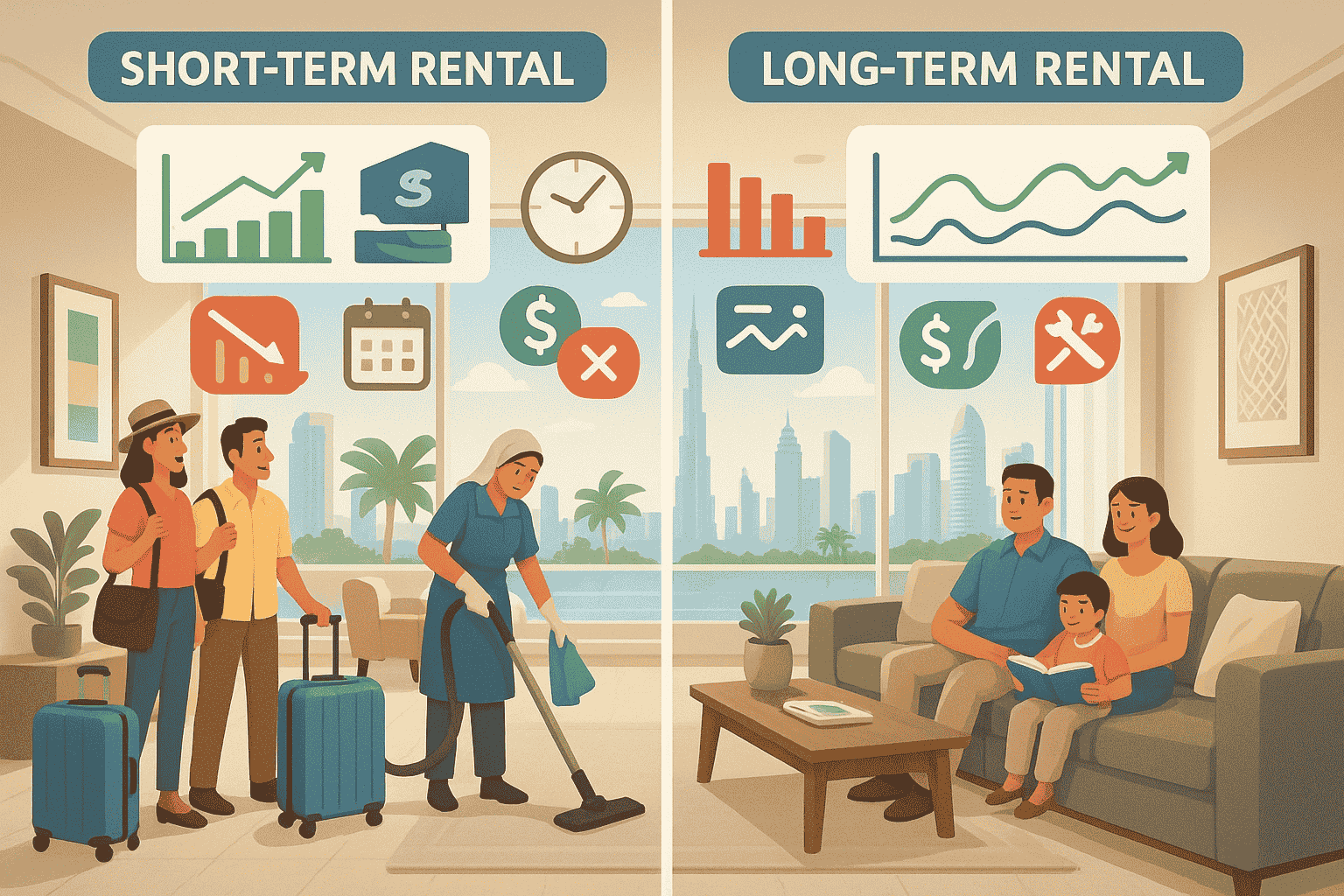Analyze the true costs and returns of short-term versus long-term rental strategies in the UAE property market, with comprehensive financial breakdowns to help investors optimize their rental income and property management approach.
The choice between short-term and long-term letting strategies significantly impacts the profitability, management requirements, and long-term success of UAE rental property investments. Understanding the real costs, potential returns, and operational implications of each approach enables investors to make informed decisions that maximize their property’s earning potential.
Short-Term Letting: The High-Yield, High-Management Strategy
Short-term rentals, typically ranging from nightly stays to monthly bookings, can generate substantially higher gross rental income compared to traditional annual leases. Prime Dubai locations can achieve daily rates of AED 800-2,500 for luxury properties, potentially generating 150-250% of annual lease equivalent income.
However, short-term letting requires significant management infrastructure including professional cleaning services, guest communication, maintenance coordination, and marketing across multiple platforms. These operational costs typically represent 35-50% of gross rental income.
Comprehensive Cost Analysis for Short-Term Rentals
Operating Expenses:
- Professional cleaning: AED 150-300 per turnover
- Platform commissions: 15-20% of booking value (Airbnb, Booking.com)
- Utilities (higher usage): AED 800-1,500 monthly
- Professional photography and marketing: AED 5,000-15,000 annually
- Guest supplies and amenities: AED 200-500 monthly
- Property management services: 20-25% of gross income
Hidden Costs:
- Increased property wear and maintenance: 200-300% of long-term rental rates
- Insurance premium increases: 15-25% for short-term rental coverage
- Vacancy periods during low seasons: 15-25% annual occupancy loss
- Emergency maintenance and guest issue resolution
Long-Term Letting: Stable Income with Lower Management Requirements
Traditional annual leases provide predictable income streams with minimal management requirements once tenants are established. Long-term rentals typically generate 85-95% occupancy rates with significantly lower operational costs representing 15-25% of gross rental income.
Long-term letting offers greater stability during economic uncertainties and requires less day-to-day management, making it suitable for investors seeking passive income with minimal time investment.
Long-Term Rental Cost Structure
Operating Expenses:
- Property management: 5-10% of annual rent
- Annual maintenance: AED 5,000-15,000
- Regular utilities (if included): AED 400-800 monthly
- Marketing and tenant acquisition: AED 2,000-5,000 annually
- Legal and documentation costs: AED 1,000-3,000 annually
Benefits:
- Predictable monthly income
- Lower management time requirements
- Reduced property wear and maintenance costs
- Simplified tax reporting and financial planning
- Better tenant relationships and property care
Market-Specific Considerations
Dubai Marina, Downtown Dubai, and DIFC areas show strong performance for short-term rentals due to business travel and tourism demand, with occupancy rates averaging 75-85% annually. These areas can justify the higher management costs through premium daily rates.
Suburban areas like Dubai Investment Park, Jumeirah Village Circle, and International City typically perform better with long-term letting strategies due to lower tourism appeal but strong residential demand from working professionals.
Seasonal Impact and Revenue Optimization
Short-term rental income in the UAE varies significantly by season, with peak periods (November-March) generating 40-60% higher rates than summer months. Successful short-term rental operators often convert to medium-term lets (3-6 months) during low seasons to maintain occupancy.
Long-term rentals provide consistent income regardless of seasonal fluctuations but may miss opportunities to capitalize on peak tourism periods and special events like Expo or major conferences.
Regulatory Compliance and Legal Requirements
Short-term rentals require specific licenses and compliance with tourism regulations that vary by emirate and building type. Dubai requires tourism licenses for properties rented for less than 30 days, while some buildings prohibit short-term letting entirely.
Long-term rentals have simpler regulatory requirements but must comply with tenancy laws, rent increase limitations, and tenant protection regulations that can impact flexibility and income adjustments.
Technology and Management Solutions
Modern property management platforms can automate many short-term rental operations including booking management, guest communication, cleaning coordination, and financial reporting. These technologies can reduce management costs to 15-20% of gross income for tech-savvy investors.
Long-term rental management benefits from property management software for maintenance requests, rent collection, and tenant communication, but requires less sophisticated technology infrastructure.
ROI Comparison and Decision Framework
Short-term rental ROI calculation:
- Gross income: AED 180,000-350,000 annually (luxury 2BR)
- Operating costs: AED 63,000-175,000 (35-50%)
- Net income: AED 117,000-175,000
- Time investment: 10-20 hours monthly
Long-term rental ROI calculation:
- Gross income: AED 120,000-180,000 annually (luxury 2BR)
- Operating costs: AED 18,000-45,000 (15-25%)
- Net income: AED 102,000-135,000
- Time investment: 2-5 hours monthly
Industry Statistics
- Revenue Differential: Short-term rentals in prime Dubai locations generate 65-85% higher gross income than long-term rentals, but net income advantage reduces to 15-25% after operational costs (Dubai Tourism Revenue Analysis, 2024).
- Occupancy Rates: Long-term rentals achieve 95% average occupancy compared to 78% for short-term rentals, with significant seasonal variation for short-term properties (UAE Property Management Association, 2024).
- Management Costs: Short-term rental operational costs average 42% of gross income compared to 22% for long-term rentals, significantly impacting net returns (UAE Rental Property Cost Study, 2024).
- Property Appreciation: Properties optimized for long-term rental show 12% higher capital appreciation due to better maintenance and tenant care compared to high-turnover short-term rentals (Dubai Land Department Property Value Analysis, 2024).



